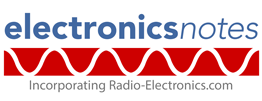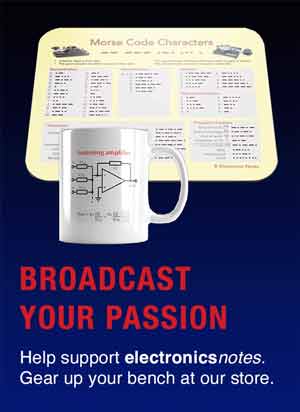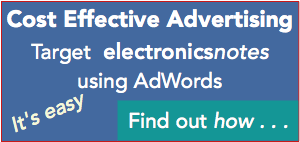Home » Component data » Diode (PN junction) data » this page
ES1A PN Junction Diode Data
Key data for the ES1A fast recovery semiconductor diode including key electrical parameters, performance, features, outline, package type and many other key datasheet details.
The ES1A is an SMD fast recovery diode intended for a variety of power applications, especially in various forms of switching power supplies where fast switching speed is required.
Key details and performance parameters for the ES1A diode.
| ES1A diode datasheet parameters & data |
|
|---|---|
| Parameters | Details |
| Diode type | Surface mount superfast rectifier |
| Package type | DO214 (also known as SMA 403) |
| Repetitive peak reverse voltage, VRRM | 50V |
| Working peak reverse voltage, VRWM | 50V |
| DC blocking voltage, VR | 50V |
| RMS reverse voltage, VR(RMS) | 35V |
| Forward continuous current, IF | 1A |
| Non-repetitive forward surge current, IFSM | 30A half sine wave 8.3ms |
| Maximum reverse current IR | 5.0µA at 25°C and 100µA at 100°C at the rated voltage |
| Junction temperature (°C) | -50 - +150°C |
| Forward voltage VF | 0.92V @ 1A |
| Diode junction capacitance CD | 7.0pF at VR = 4V |
| Reverse recovery time (Trr) | 15ns |
Outline & pinout:
Explanation of major diode parameters
| Parameter | Explanation |
|---|---|
| Repetitive peak reverse voltage, VRRM | This is the maximum value of the short period peak reverse voltage that can be sustained. |
| Working peak reverse voltage, VRWM | This is the maximum value of the continuous reverse voltage that can be applied to the diode. |
| DC blocking voltage, VR | This is the maximum reverse DC voltage that should be applied across the diode. |
| RMS reverse voltage, VR(RMS) | As many AC waveforms are quoted in RMS, this is the maximum reverse voltage that can be sustained where the voltage is expressed in terms of its RMS value. |
| Forward continuous current, IF | This is the maximum forward current that can be sustained by the diode. |
| Average rectified current, IF | This is the maximum average current value that can be handled by the diode. The parameter often states the load as this will affect the operation of the diode. |
| Non-repetitive forward surge current, IFSM | This is the maximum surge current that can be handled - it should only be present for a short time. |
| Parameter | Explanation |
|---|---|
| Power dissipation, PTOT | The maximum power dissipation that can be sustained within the device. |
| Junction temperature (°C) | This is the maximum temperature of the PN junction that can be sustained. Remember that the junction temperature can be much higher than the ambient temperature of the equipment. |
| Forward voltage VF | This parameter gives the forward voltage drop for a particular current passed through the diode. |
| Breakdown voltage VBR | This is the minimum voltage at which the diode may breakdown. If the current is not limited it will lead to the destruction of the device. |
| Leakage current IR | This is the current that flows under stated conditions when the diode is reverse biassed. |
| Diode capacitance CD | The diode capacitance, CD may also be referred to as the junction capacitance, CJ. All diodes have a certain capacitance across the PN junction. The value will be stated for a given reverse voltage. |
| Reverse recovery time | If a diode is initially driven in forward bias, and the polarity suddenly switches to reverse bias, the diode will still remain conducting for some time. The reverse recovery time is the time required for conduction to settle into the reverse bias state. |
These are the main diode parameters that have been included in our list. There are others, but these help quantify the main elements of the performance of the diode.
Please note, that the data given is the best estimate we can give within a tabulated summary of this nature. Parameters also vary between manufacturers. Electronics Notes cannot accept any responsibility for errors, inaccuracies, etc, although we do endevaour to ensure the data is as accurate as possible.
Notes and supplementary information
• Availability & sources
The ES1A is available from a number of stockists and electronic component distributors many of which are given in the table below.
ES1A Component Distributor, Stock and Pricing
• Notable features
The ES1A is a fast recovery rectifier diode designed for surface-mount applications requiring compact size and efficient high-speed switching performance.
Rated reverse voltage : 50 V maximum repetitive peak reverse voltage (VRRM)
Forward current rating : 1.0 A average forward rectified current (IF(AV))
Fast reverse recovery time : Typically 15 to 25 ns, making it suitable for high-frequency switching applications
Low forward voltage drop : Around 0.95 V maximum at 1 A, reducing conduction losses
High surge current capability : Up to 30 A non-repetitive peak surge current (IFSM)
Surface-mount package : Provided in the compact DO-214AC (SMA) SMD package for automated PCB assembly
Low leakage current : Typical reverse leakage of ~5 μA at 50 V
Glass-passivated junction : Enhances reliability and thermal stability
Wide operating temperature range : −55°C to +150°C junction temperature range
RoHS compliant / Lead-free : Environmentally friendly and compatible with modern manufacturing requirements
• Typical applications summary
| Application Category | Typical Use Case | Device Feature Utilised |
|---|---|---|
| Switch-mode Power Supplies (SMPS) | High-speed rectification in output stages | Fast reverse recovery and low forward drop |
| DC-DC Converters | Freewheeling or catch diode in buck/boost converters | Fast switching capability and surge current handling |
| Reverse Polarity Protection | Protecting circuits from accidental reverse voltage | Low forward voltage drop in conduction path |
| General Purpose Rectification | Low-voltage AC to DC conversion | 1 A current handling and compact SMD form |
| Inductive Load Suppression | Flyback diode across relays, solenoids, and motors | Fast recovery and surge current endurance |
| Battery-powered Devices | Polarity protection or charging path control | Low power loss and compact package |
 Written by Ian Poole .
Written by Ian Poole .
Experienced electronics engineer and author.
Return to Component Data menu . . .




